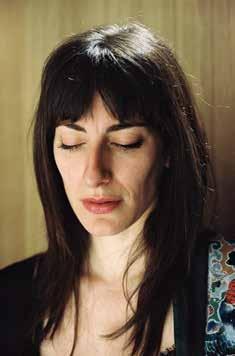
4 minute read
In Conversation with artist Janis Rafa at the Venice Biennale
Meet Janis Rafa, the Greek artist at the current Venice Biennale
Entitled Lacerate, Rafa’s video presented at the Arsenale, takes us to a timeless space, to a crumbling mansion, with a herd of hunting dogs inhabiting it (or perhaps, entrapped in it). Gradually, the images reveal, in the absence of voice-overs or texts, the animals sniffing around, and the body of a man who seems to have been killed. The last few shots show a woman looking directly at the viewer and leaving with the dogs. “I wanted to talk about violence against women and more generally, about violence in relation to the environment. This work was commissioned by the Fondazione In Between Art Film to create a video related to inclusion and how it relates to domestic violence. As I did not want to show the woman as a victim again, I reversed the roles. My main references were the Flemish paintings, Renaissance paintings, and especially the work of the painter of the early Roman Baroque period Artemisia Gentileski, whose works have centered around the subject of revenge against the male sex.” As a subject, violence is not something new in my work, but in this case, the work also touches on
Advertisement

how it has been portrayed through the male gaze in Western art history. “I create sculptures and works in the whole range of animation (from video to feature film) and most of them have to do with the landscape and the coexistence of people and animals, living and dead.” “I am constantly renegotiating who we are and how we exist, animalism and mortality, and I try to create similarities that bring us closer to our nature, to other beings and to the environment”. We have perceived our existence as humancentered, egocentric, leaving out other types of life, without whom we could not exist. Joà Grammenou speaks at length to Janis Rafa, the only Greek artist participating in The Milk of Dreams curated by Cecilia Alemanni, at the current Venice Biennale. Requiem to a Shipwreck (Requiem#1), 2014. Film still, single channel video with sound, 11 min. Courtesy the Artist; Museum Voorlinden

There is also talk of whether animals feel or should grow up in meat industries, questions that should be considered obsolete. The coronavirus pandemic has brought the post-human dialogue even more actively to the fore. “Ritual forms of separation or contact with dead beings are a frequent reference in my work. Animals too are an integral part of my work. Growing up with pets, I had to say goodbye to them at some point, and I think that helped me to seek beings (eg strays, or birds that have been hunted down), that are all too easily overlooked. So suddenly, another perception is created. From the behavior of animals, I learned to be very observant, and the fact that they do not need speech, also helped my own perception of things”.
There is a flow, a dialogue that goes from project to project. I want my filmography to unfold a world, a universe reminiscent of the familiar environment in which we live, but some hierarchies and patterns have been rearranged: the animal comes to the fore or is equal to the human; human bodies are more exposed, more ‘stray’ or homeless, more vulnerable, more mortal. I always wanted to be an artist. My mother is a painter, and I grew up in the 90’s in an artistic and bohemian environment, painting and sculpting. At 18, I realized that I was interested in “playing” more with the camera. I studied at the University of Leeds in England because I wanted to work in new art forms and because it offered a very good combination of theoretical and practical training. Art has given me the freedom to be able to create from scratch, to go either instinctively or to research in areas that interest me. I am currently working on a short film, commissioned by Art for the world, about the coexistence of humans, animals and the environmental crisis. My work will be called Landscape Depressions, to be filmed very likely near Lake Plastira, recording a moment when the animals will be in the early stages of their freedom because humans will be in a state of hypnosis. My goal is to comment on the scenario that nature could take revenge on us. What is bothering me at this moment? The stray body, which is not only not documented, but not accepted, not included. How are lives recorded, human and non-human, from refugees and migrants to stray animals? And all this in relation to the concept of motherhood: how does a human mother look into the eyes of an animal mother and not feel guilty about the children of the animals we eat every day?

Lacerate, 2020. Film still, single-channel video with sound, 16 min. Courtesy the Artist; Fondazione In Between Art Film

A Sign of Prosperity to the Dreamer, 2014. Film still, double channel video with sound, 16 min










